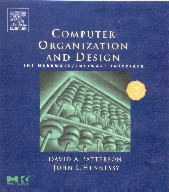 |
| (Textbook. Click for information.) |
Computer Organization II
Fall 2004
Recitation 9
addi in single- / multi-cycle
Week 9: Oct 18-22
Due (on time): 2004-10-27 23:59:59
Due (late): 2004-10-31 23:59:59
Recitation 9 must be submitted
following directions at: submissions on or before
|
Outline: This recitation studies the addi instruction in both the single-cycle and multi-cycle implementation. In summary, you are to create a data path diagram showing how the addi instruction can be carried out in each of these two implementations. Your diagrams should be similar to those given out in class. (Diagramming the instruction for the single-cycle model is an exercise in your text.) It is interesting (and it's a big hint), that no real additional control or data lines are needed for the implementations.
| Instruction: addi $t3, $t2, 45 | ||||
|---|---|---|---|---|
| 214b002d | (in hexadecimal) | |||
| 001000 | 01010 | 01011 | 0000000000101101 | (fields in binary) |
| 8 | 10 | 11 | 45 | (fields in decimal) |
In marking the values traveling along data lines, assume that $t2 = $10 holds the value 51 and that $t3 = $11. (Note that the ALUOp control can be two 0 bits, so that the input to the ALU from ALU control will then be 010, that is, an add.)
|
Contents of submission
for Recitation 9: Last Name, First Name; Course Number; Recitation Number (9).
|